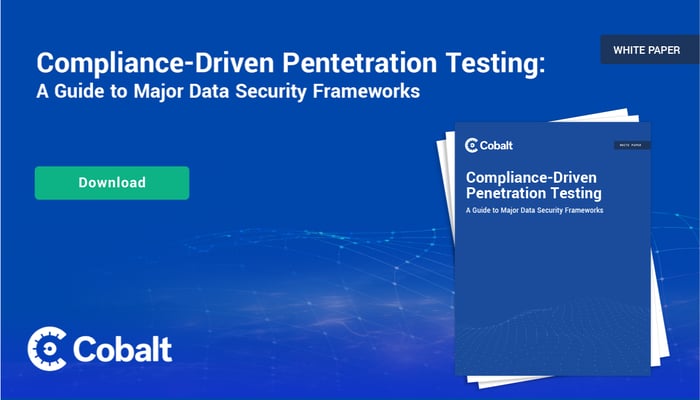With the rise of mobile technology, cloud services, remote work, and AI, web applications have become a primary target for cybercriminals. A web application penetration test can help you discover and fix vulnerabilities in your web-based apps before attackers find and exploit them. Here’s an introduction to web application pentests, how they work, what types of vulnerabilities they uncover, and how to apply recommended remediations.
What Is a Web Application Pentest?
Web application pentests simulate attacks on web-based apps in order to uncover vulnerabilities, prioritize risks, and propose remediations. Running web app pentests helps organizations prevent breaches, achieve compliance, and enhance security.
Web application pentests use standard frameworks and knowledge bases to categorize and check for vulnerabilities.
Pentesters first define testing scope and gather reconnaissance on web apps in order to map attack surfaces and identify vulnerabilities. Testers then attempt to exploit vulnerabilities. The testing process yields reports which itemize and prioritize risks and recommend remediations. After remediations have been implemented, teams may run retests to verify that risks have been mitigated.
Web application pentests can be applied to internal-facing or public-facing apps. They can be used to test production code, code in development, integrations with other apps, specific business processes such as payment processing, or specific vulnerabilities such as access control.
A web application pentest can be comprehensive in scope, mapping an app’s entire attack surface. Alternately, a test can focus on a specific part of the attack surface, enabling testing to be deployed more quickly. Granular testing often supports a shift-left security methodology which seeks to pre-empt vulnerabilities throughout the software development lifecycle.
Web app pentesters may conduct tests with complete knowledge of coding and architecture (white box pentesting), no knowledge beyond app input and output (black box pentesting), or partial knowledge of internal coding and structure (gray box pentesting). White box testing helps with in-depth code reviews, while black box testing simulates outsider attacks, and gray box testing simulates insider attacks.
Importance of Web Application Penetration Testing: Why it Matters
Web app pentesting has become increasingly vital for cybersecurity for a number of reasons:
- Growing risk to web apps: As businesses have moved to the cloud and employees and customers have moved to mobile devices, web apps have become more vital for business operations, making them a priority target for cybercriminals.
- Changing risk landscapes: Attackers targeting web applications are constantly changing tactics using increasingly powerful tools such as AI-automated algorithms, making ongoing pentesting critical to maintain a strong security posture.
- Compliance requirements: Major regulatory compliance frameworks such as the Payment Card Industry Data Security Standard (PCI-DSS) and the Health Insurance Portability and Accountability Act (HIPAA) either require pentesting or include requirements that make pentesting advisable, and many clients also require pentesting specs.
- Secure software development lifecycle policies (SSDLC): Both regulatory requirements and industry policies have promoted a “shift-left” approach to security that promotes pre-emptive testing for vulnerabilities throughout the software development lifecycle.
- Efficiency and cost-efficiency: Using pentesting to catch vulnerabilities before code goes into production and before breaches occur can save security teams time and money.
- Reputation management: Preventing breaches through pentesting helps protect brand reputation with customers and investors, promoting profitability.
These realities provide a compelling rationale for incorporating web application pentesting into cybersecurity policies.
How Web Application Penetration Testing Differs from Other Types of Testing
Web application penetration testing is one type of pentesting, which is in turn one of several major offensive security (OffSec) testing methods. Pentesting, which simulates attacks on an entire attack surface or part of an attack surface, can be applied to other digital properties besides web applications, including:
- Mobile applications
- Desktop applications
- AI and LLM applications
- Internal networks
- External networks
- APIs
More broadly, pentesting can be distinguished from other types of offensive security, which includes any proactive security method that mimics attacker strategies in order to mitigate vulnerabilities before real hackers find them. Other major offensive security approaches include:
- Vulnerability scanning: Vulnerability scans use automated tools or manual methods to identify potential vulnerabilities, screen out false positives, and isolate actual risks.
- Red teaming: Red teams simulate actual attacks on vulnerabilities real hackers are most likely to exploit, in contrast to pentesting’s more systematic approach to uncovering vulnerabilities.
Vulnerability scanning, red teaming, and other OffSec methods can support and enhance pentesting. Vulnerability scanning often serves as a preliminary for pentesting, helping testers analyze defense gaps to be probed. Red teaming can be used to verify the effectiveness of mitigations implemented after pentesting, or it may uncover vulnerabilities that prompt pentests.
Popular Methodologies
Web application penetration testing deploys methodologies and knowledge bases developed by industry leaders and pentesting communities. Two of the most popular frameworks are:
- The Open Worldwide Application Security Project (OWASP) Top Ten, a list of priority vulnerabilities and corresponding mitigations identified by an open-source community project
- MITRE ATT&CK, developed by the MITRE Corporation
OWASP has been tracking application security risks and publishing findings since 2003, periodically ranking the ten most urgent risk priorities. OWASP’s 2021 update consolidated a prior 2017 update and added several new risk categories, prioritizing broken access controls, cryptographic failures, and injection attacks. A November 2025 update incorporates emerging risks posed by trends such as AI and supply chain vulnerabilities.
MITRE ATT&CK takes a more systematic approach, using a step-by-step breakdown of attack phases to list the tactics, techniques, and procedures (TTPs) attackers might use in each phase, along with corresponding mitigations. MITRE’s framework serves to help pentesting teams model threats facing attack surfaces.
Cobalt’s web application pentesting methodology leans on OWASP, though informed by MITRE and other frameworks and knowledge bases as well. The complete Cobalt pentesting strategy includes eight phases:
- Target scope reconnaissance: Gathering and analyzing public information about targeted applications to confirm accessibility, permissions, and functionality
- Business and application logic mapping: Manual review of business logic, workflows, and access controls
- Automated web crawling and web scanner configuration: Scans of endpoints, input fields, hidden parameters, and dynamic pages to improve detection accuracy and minimize noise
- Vulnerability scanning: Running scans from the perspective of outsider or insider attackers, as testing scope dictates
- Manual web vulnerability tests and exploit reviews: Conducting manual reviews to identify vulnerabilities missed by automated scans
- Advanced security testing for modern web apps: Tests geared toward risks presented by trends such as single-page applications (SPAs), microservices, and cloud-based apps, reviewing elements such as client-side JavaScript, WebSockets, and cross-origin resource sharing (CORS)
- Ongoing security assessments and continuous testing: Real-time collaboration with developer and security teams to analyze risks, prioritize vulnerabilities, and recommend remediations
- Reporting, triaging, and retesting: Generating result reports, prioritizing remediations, and verifying implementations
Some of these phases may be more relevant to certain pentests than others. The tools used in each phase may vary from one test to another.
Web App Penetration Testing Process
When Cobalt conducts a web application pentest in collaboration with a client using Cobalt’s pentesting as a service (PTaaS) platform to deploy continuous pentesting, the phases above get implemented through a six-step iterative process:
- Discovery
- Planning
- Testing
- Remediation
- Retesting
- Analyzing
Discovery maps web application attack surfaces to identify which ones need testing. This can include mapping of URLs, subdomains, business logic, key functionalities, critical assets, high-value targets, user roles, access controls, business logic bypass abuses, session and authentication mechanisms, and client-side vs. server-side controls.
Planning prioritizes and scopes pentests to align with business and security goals. This includes planning schedules, resource allocation, and budgets to ensure continuous coverage across your web apps and digital ecosystem.
Testing connects clients with expert pentesters matching technology stack requirements to analyze target apps for vulnerabilities. This is the core of the pentesting process.
Remediation begins as tests are underway, with Cobalt pentesters reporting in real-time to developers and security teams so they can begin mitigating high-priority findings immediately. This continuous approach avoids delaying fixes until pentesting is completed, characteristic of traditional pentesting approaches, reducing opportunities for attackers to exploit vulnerabilities while tests are still ongoing.
Retesting follows report and mitigation completion to verify fixes and update final reporting. All pentests include free retesting of individual findings for either six-month or twelve-month periods.
Analysis summarizes final pentest report insights after retesting and provides an executive overview for key stakeholders. This gives organizations the ability to track results over times and leverage actionable insights in alignment with security, compliance, and business strategies and policies, providing a basis for iterative, ongoing, continuous improvements and optimization of security posture.
Common Vulnerabilities in Web Applications
Web applications have many potential vulnerabilities, so OWASP prioritizes the most prevalent risks for pentesters. Today’s leading web application vulnerabilities include:
- Broken access control: allowing users to access accounts or functionality outside their permission restrictions
- Cryptographic failures: exposing sensitive data or functionality through encryption errors, such as sending credentials in cleartext, applying outdated algorithms, or using default crypto keys
- Injection: Enabling malicious input, queries, calls, or similar attacks through weaknesses such as poor validation, filtering, and user input sanitization
- Insecure design: neglecting security features during web app development
- Security misconfiguration: Insecure configuration of elements such as enabled ports, default passwords, cloud service permissions, or APIs
- Vulnerable and outdated components: overlooking controls such as vulnerability scanning, version tracking, or software updates
- Identification and authentication failures: authentication flaws such as failing to safeguard against weak passwords, credential stuffing, or brute force attacks
- Software and data integrity failures: vulnerabilities such as employing insecure CI/CD pipelines, importing resources from insecure libraries, or running auto-updates without integrity checks
- Security logging and monitoring failures: neglecting to track security events, distribute alerts, or initiate follow-up actions
- Server-side request forgery: enabling apps to call remote resources without URL validation
Recent trends such as AI and LLM apps and integrations and attacks on supply chains have aggravated some of these vulnerabilities and introduced new ones, which are addressed in the 2025 OWASP Top 10 update.
How to Prioritize and Remediate Web Application Findings
Vulnerabilities uncovered by pentesting may vary widely in severity and urgency, so pentesters use scoring systems to prioritize remediations. OWASP scores risk based on a combination of the likelihood of exploitation and impact on technical and business operations. Within this framework, Cobalt pentesting reports classify risks using a system ranging from minimal risks to those requiring immediate attention:
- Critical: requires immediate attention
- High: impacts app security with high probability of exploits and/or business impact
- Medium: encompasses combinations of medium risk and medium impact, low risk and high impact, high risk and low impact
- Low: common vulnerabilities with minimal impact.
- Informational: minimal business risk
To assist with remediation, Cobalt integrates with popular project management, repository management, incident management, workflow automation, and support ticket apps, while supporting customized integrations. Common integrations include:
- Asana
- Bitbucket
- PagerDuty
- PivotalTracker
- ServiceNow
- Trello
- Zendesk
Complementary retests of individual findings are available for six-month or twelve-month periods.
To learn more about penetration testing, visit Cobalt’s learning center.







